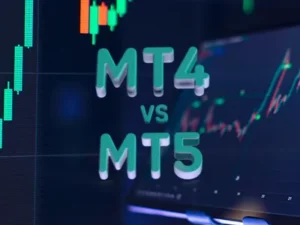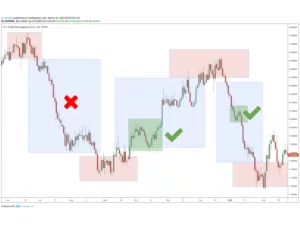Artificial intelligence and algorithmic trading are changing how forex traders make decisions. Instead of relying only on manual analysis, traders now use systems that can analyze huge amounts of data, detect trading patterns, and execute trades within seconds. These tools reduce human error and allow faster, data-driven trading in a 24-hour global market.
AI programs use price history, market volume, and news data to predict short-term movements. Algorithmic systems can test thousands of strategies and automatically execute trades once the right conditions appear. For instance, an AI-based robot can scan multiple currency pairs and open trades that match specific patterns while following risk limits. The future of forex trading will rely more on smart automation, allowing both individual traders and institutions to trade more efficiently.
What Is Algorithmic Forex Trading
Algorithmic forex trading has become one of the most important developments in modern financial markets. It allows traders to automate their strategies, improve accuracy, and execute trades faster than any human can react. Instead of manually analyzing every chart or news update, traders can rely on software that follows a pre-defined set of rules. This automation ensures discipline, consistency, and efficiency, which are essential in a volatile market like forex.
Definition and Purpose
Algorithmic trading refers to the use of computer programs to execute trades automatically based on specific criteria such as price levels, indicators, or time. These systems remove emotional influence from trading decisions by operating strictly according to pre-set rules. Traders can code their strategies or use pre-built algorithms offered by brokers. The goal is to achieve steady performance, accurate execution, and better risk management.
Why It’s Growing Fast
The growth of algorithmic trading in forex is driven by increasing market speed and data availability. Automation allows traders to react instantly to price changes, reducing delays caused by manual actions. Institutional investors and retail traders both use algorithmic systems for consistency and precision. With the advancement of cloud technology and AI integration, algorithms can now process vast amounts of data in milliseconds — giving traders an edge in fast-moving markets.
Role of AI in Forex Trading
Artificial intelligence (AI) has taken algorithmic trading to the next level by enabling systems to think, learn, and adapt on their own. Unlike basic automated strategies that follow fixed logic, AI systems can interpret complex data, recognize market patterns, and adjust trading plans in real time.
How AI Works in Trading
AI in forex trading works by analyzing large sets of market data — including price charts, news releases, and even social media sentiment — to identify profitable opportunities. It uses natural language processing (NLP) to interpret financial news and machine learning to refine strategies over time. These intelligent systems can detect early signals of trend changes and execute trades automatically without human delay.
Machine Learning Models
Machine learning models are a key part of AI trading systems. They evaluate previous trades, learn from mistakes, and adjust strategies to improve performance. The more data they process, the smarter they become. Over time, this self-improvement helps increase accuracy, reduce losses, and optimize trading behavior based on evolving market conditions. Many AI models use neural networks and predictive analytics to forecast future price movements more effectively than manual analysis.
Major Benefits of AI-Based Forex Systems
AI-based trading systems provide a wide range of advantages for both beginners and professionals. They combine speed, accuracy, and adaptability to create more reliable trading results.
Key Advantages
- Fast trade execution – Orders are placed within milliseconds, avoiding slippage.
- Reduced emotional errors – Eliminates impulsive or fear-based decisions.
- Backtesting and strategy optimization – Traders can test strategies using past data before trading live.
- 24/7 monitoring of multiple pairs – AI can analyze several markets at once without fatigue.
These benefits make AI trading an efficient and disciplined approach to forex, minimizing human error while maximizing efficiency.
Real Trading Use
Many modern brokers now integrate AI tools directly into their platforms. These tools monitor market conditions, analyze real-time data, and filter out false trading signals. They also track key economic events like central bank announcements and global policy changes to adjust trades automatically. In practice, traders use AI to improve entry accuracy, manage positions, and make data-driven decisions without constantly monitoring the charts. Over time, these systems help traders save time, control risk, and maintain consistent performance in the ever-changing forex market.
Future Trends in AI and Automation
The next decade of forex trading will be driven by rapid advancements in artificial intelligence, machine learning, and automation. As technology improves, AI systems will not only execute trades but also understand context, market mood, and global events in real time. Traders will move from manual decision-making toward full automation, where algorithms continuously learn, test, and optimize strategies without constant human input. This shift will make trading more precise, efficient, and accessible to smaller investors.
Self-Adapting Trading Systems
AI is evolving to a level where trading robots will automatically adjust their strategies based on changing market conditions. These systems will track volatility, liquidity, and price momentum to adapt instantly. For example, during quiet sessions, they can switch to range trading, while in volatile times, they might use breakout or trend-following strategies. Such adaptability will help minimize losses and capture opportunities faster than manual methods.
Integration with Big Data
AI will increasingly rely on big data sources such as news feeds, social media trends, and sentiment analysis to forecast currency movements. By processing millions of data points per second, these systems can detect hidden correlations between global events and market reactions. Traders will use dashboards that combine macroeconomic reports, social sentiment, and live charts to make more informed decisions. This integration will lead to a more predictive and data-based trading environment, reducing guesswork and improving accuracy.
Risk Management with AI Systems
AI will redefine how traders handle risk by introducing advanced, automatic controls that reduce exposure without emotion or delay. Instead of manually calculating stop-loss or position size, traders will rely on systems that make instant, data-driven adjustments.
AI-based tools can measure risk per trade, track total portfolio exposure, and automatically adjust order sizes based on account balance and volatility. These systems can also prevent overtrading and identify when a trader’s behavior deviates from their plan. By learning from past performance, AI can fine-tune strategies to reduce future losses.
Suppose an AI system detects rising volatility in EUR/USD due to an unexpected ECB statement. The algorithm can immediately reduce trade size, tighten stop-loss levels, or close positions to protect capital. This automation eliminates emotional errors and ensures consistent discipline during fast market moves. Over time, AI-driven risk control helps traders preserve funds and maintain long-term profitability.
Comparing Manual and Algorithmic Trading
Manual and algorithmic trading differ not only in speed but also in accuracy, emotional control, and data processing capacity.
| Feature | Manual Trading | Algorithmic Trading |
|---|---|---|
| Speed | Slow | Instant |
| Emotion | High | None |
| Analysis | Limited | Data-based |
| Monitoring | Constant attention | Automated |
Algorithmic systems can monitor multiple pairs, interpret news instantly, and execute trades within milliseconds. They operate without fatigue or bias, offering consistent performance even in volatile markets. Unlike manual traders who may miss opportunities or overreact emotionally, algorithms follow set rules with discipline. This gives them a significant advantage in markets where reaction time and precision determine success.
Ethical and Legal Aspects of AI Trading
AI-driven trading is becoming more common in forex markets, but it brings new ethical and legal responsibilities. While automation increases efficiency and accuracy, traders must ensure that their use of AI follows both national and international financial laws. In India, AI-based trading must comply with SEBI and RBI guidelines, ensuring all algorithms are transparent, tested, and free from market manipulation. Using unregulated or third-party bots without proper verification can lead to violations of trading norms or even account suspension by brokers.
Regulation and Transparency
AI trading must follow strict financial regulations and data protection standards. Algorithms should operate under clear, auditable logic to prevent manipulation or misuse of personal data. Regulatory bodies such as SEBI and the Reserve Bank of India are working toward establishing frameworks for algorithmic trading oversight. Unregulated robots can disrupt market stability by placing large numbers of orders automatically without proper risk control. Therefore, traders must only use bots approved by licensed brokers and hosted on secure servers.
Safe Use
Before connecting an AI trading system to a live account, traders should test it in demo or simulated environments for at least a month. This helps evaluate performance, reaction time, and error handling under real market conditions. Avoid purchasing bots from unverified sources or online forums. Instead, choose AI solutions provided by reputable, regulated brokers or developers who disclose full system details. Regular monitoring is also necessary — never leave an AI system completely unattended, as markets can shift rapidly due to unexpected news or policy changes.
How Traders Can Prepare for the Future
The future of forex trading will rely heavily on automation, data analysis, and AI-powered decision-making. Traders who adapt early will have a strong competitive advantage. Building a mix of technical and analytical skills will help individuals understand, manage, and optimize AI-based systems effectively.
Skill Development
To stay relevant, traders should learn coding basics such as Python or MQL (MetaQuotes Language), which are widely used in algorithmic trading. Understanding data analysis, machine learning, and backtesting tools helps improve trading strategies. Knowledge of API connections and automation platforms like MetaTrader 5 or TradingView can make traders more independent and better equipped for future markets.
Continuous Learning
Markets evolve quickly, and so does technology. Stay updated by following AI trading news, attending webinars hosted by regulated brokers, and reading reports from trusted financial technology sources. Joining trading communities and online AI discussion forums helps share knowledge and discover new tools safely. Continuous learning ensures traders can adapt to new systems and take advantage of future innovations without falling behind.
Expected Market Changes Ahead
As artificial intelligence continues to advance, the forex market will become faster, more accurate, and data-driven. Traders will need to blend human experience with machine precision to stay competitive.
More Data-Driven Decisions
Future forex trading will rely on AI-driven models capable of analyzing massive datasets — from economic indicators to real-time sentiment analysis. Automated systems will make faster predictions and execute trades within milliseconds. This shift will improve efficiency but also increase the importance of ethical algorithm design to prevent manipulation or biased data usage.
Increasing Role of Institutions
Banks, hedge funds, and large financial institutions are already investing heavily in AI infrastructure. Their goal is to develop trading systems that can predict market shifts, manage liquidity, and reduce transaction costs. This institutional dominance will likely shape future market volatility and trading speed. For retail traders, the key will be to use technology wisely, remain compliant with regulations, and continuously update skills to keep pace with this AI-driven evolution in forex trading.



